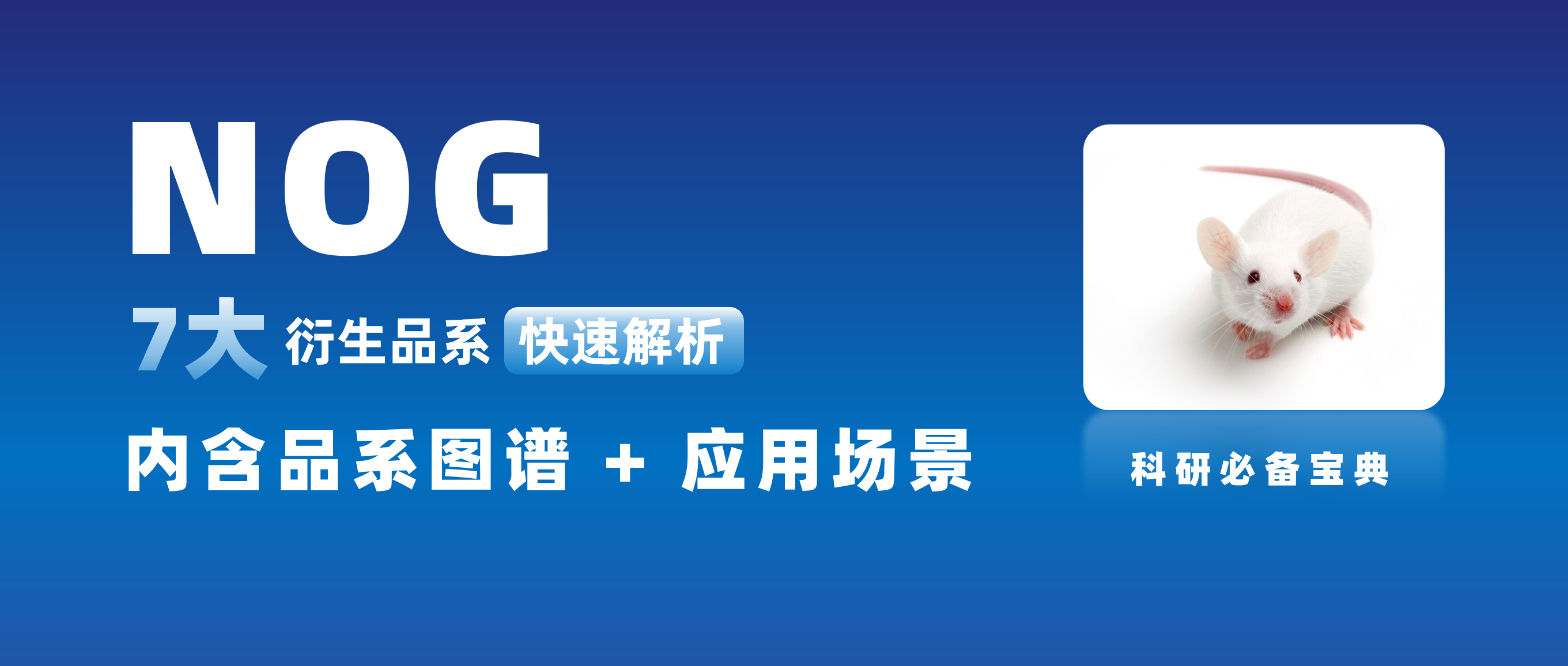.jpg)
NOG-EXL Mice (hGM-CSF-hIL-3 NOG)
410
NOD.Cg-Prkdcscid Il2rgtm1SugTg(SV40/HTLV-IL3,CSF2)10-7Jic/JicCrl
【日本CIEM正式授权】肿瘤生物学、异种移植研究
品系来源
NOG-EXL(hGM-CSF/hIL-3 NOG)小鼠是由日本中央实验动物研究所(CIEM)的Mamoru Ito博士培育而成。Mamoru Ito博士实验室将携带hIL-3和hGM-CSF的转基因载体共同显微注射到已受精的BDF1 X B6 SCID受精卵中,构建出founder品系。该founder再与NOG小鼠回交12代以上培育而成的品系。
【维通利华 - 中国大陆地区CIEM官方授权经销商 - NOG模型系列】
✈ 2018年,维通利华从CIEM引入该品系核心群。
科研必备:不同NOG衍生品系的特点与应用场景解析
应用特性
研究用途:
- 人源化免疫系统重建(huHSC-NOG-EXL)
- 肿瘤免疫治疗
- CAR-T药物的安全性评价
- 急性骨髓性白血病 (AML)研究模型
- 炎症研究:哮喘、过敏性疾病等研究
特性:
毛色:白化
除了NOG小鼠的特性外,还具备以下特性:
- 表达人源因子GM-CSF和IL-3,且表达量适中,与人类相似。
- huHSC-CD34+ 移植后,一般在100天左右部分个体因贫血出现状态差、死亡。最长寿命可达 7 个月。
- 对辐射较敏感,X 射线的辐射剂量不要超过 2.0Gy。
- huHSC-CD34+ 移植后,不仅可以分化出淋巴细胞 , 还可以分化出多种髓系细胞( 粒细胞, 单核细胞,巨噬细胞等 ),是目前免疫系统人源化最完全的模型。
- 相较于基础 NOG/NSG,huHSC-CD34+ 移植后,人源免疫系统重建率更高。
- 可进行 huHSC-CD34+ 和人源肿瘤细胞系 / 组织块(CDX/PDX)的共同移植。
huHSC NOG-EXL模型
将人源造血干细胞(huHSC-CD34+)移植到 NOG-EXL(hGM-CSF/hIL-3 NOG)小鼠中,制备的人源免疫系统重建模型。

➢多种免疫细胞重建,包括 T 细胞和B 细胞, 粒细胞,单核细胞, 巨噬细胞等
➢可在该模型内研究更多免疫细胞及分子参与的肿瘤免疫疗法
髓系细胞能够浸润到肿瘤内部,参与免疫抑制作用,更好地模拟了人类复杂的肿瘤异质性及肿瘤微环境,所以髓系细胞的重建非常重要。人源化 NOG-EXL 小鼠(huHSC-NOG-EXL)的优势在于 , 该模型不仅能研究效应 T 细胞及调节 T 细胞的功能,也能研究浸润于肿瘤内部的髓系细胞与肿瘤的相互作用,这样就可以在一个动物模型内研究更多免疫细胞参与的肿瘤免疫疗法。
价格规格
| 品系代码 | 品系名称 | 日/周龄 | 性别 | VAF/SPF级 | Elite/SPF级 |
| 410 |
NOG-EXL
|
1-8周
|
雌
|
1580 |
*以上规格与价格自2025年1月1日至2025年12月31日有效。
| 人源化模型 | 性别 | 价格 | 模型简介 |
| huHSC-NOG-EXL |
雌
|
6000 | 将人源造血干细胞CD34+移植到重度免疫缺陷NOG-EXL小鼠中,制备的人源免疫系统重建小鼠 |
*以上规格与价格自2025年1月1日至2025年12月31日有效。
周龄体重参考
| 品系 | 性别 | 4周 | 5周 | 6周 | 7周 | 8周 | 9周 | 10周 |
| NOG-EXL | 雌 |
12-18 |
13-19 |
14-20 |
15-21 |
16-22 |
17-23 |
18-24 |
应用文献
NOG-EXL Publications
|
Authors |
Year |
Paper Title |
Keywords |
|
Fangzhou He, et al. |
2025 |
Integrative analysis of Ewing’s sarcoma reveals that the MIF-CD74 axis is a target for immunotherapy |
Immunotherapy, Immune modulatory, Ewing’s sarcoma, T cell, Macrophages |
|
Kelley Weinfurtner, et al. |
2025 |
Human GM-CSF/IL-3 enhance tumor immune infiltration in humanized HCC patient-derived xenografts |
GM-CSF,IL-3,immune cell infiltration,HCC patient-derived xenograft tumors |
|
Natasa Obermajer, et al. |
2025 |
JNJ-78306358, a first-in-class bispecific T cell |
JNJ-78306358, an HLA-G x CD3ε T cell engaging bispecific antibody (bsAb) |
|
Bhavna Verma, et al. |
2025 |
immunograft; autologous stem cells; PDX; autologous xenograft, mobilized peripheral blood (MPB)-CD34 cells |
|
|
Chao Zhao, et al. |
2025 |
non-small cell lung cancer; epidermal growth factor receptor; exosomes; apoptosis |
|
|
Lei Ye, et al. |
2025 |
endometrial carcinoma (EC), hydrocarbon receptor nuclear translocator-like (ARNTL),glycolysis, tumorigenicity, metastatic |
|
|
Bihui Cao, et al. |
2025 |
Microwave ablation (MWA) ,CAR-T, SIRPa variant (CV1), macrophage,abscopal effect |
|
|
Liang Zhao , et al. |
2025 |
68Ga-NK224,PD-L1, PET/CT, small-animal PET imaging, U87-MG |
|
|
Jay M Gamma, et al. |
2024 |
Acute myeloid leukemia (AML),Zelenirstat,N-myristoyltransferases (NMT),PDX |
|
|
Kostlan RJ, et al. |
2024 |
prostate cancer,22Rv1,metastasize, human immune system,castration |
|
|
J. R. Richardson, et al. |
2024 |
tumor-associated macrophages (TAMs), CD34+ cell donors, pharmacokinetics, anti-tumor efficacy |
|
|
Nguyen, et al. |
2024 |
CAR-T, macrophage, monocyte, cytokine release syndrome (CRS), IL-6, HSC-NOG-EXL |
|
|
Dong Zhang, et al. |
2024 |
TNFSF11/TNFRSF11A Axis Amplifies HDM-Induced Airway Remodeling by Strengthening TGFβ1/STAT3 Action |
TNFSF11; TNFRSF11A; HDM; airway remodeling, asthmatic |
|
Dong Zhang, et al. |
2024 |
human IL-33, asthmatic, huHSC-NOGEXL |
|
|
Satoshi Kaito, et al. |
2024 |
HMAs, myeloid malignancies, TOPORS, DNMT1, |
|
|
Ruoshuang Han, et al. |
2024 |
Osimertinib, Drug resistance, Anti-angiogenesis, Tumor microenvironment |
|
|
Stecklum, Maria, et al. |
2024 |
Humanization of NOG mice and next generation NOG mouse strains |
Humanized mice,CD34+HSC |
|
Danny V. Jeyaraju, et al. |
2024 |
acute myeloid leukemia (AML) , leukemic stem cell (LSC) , azacitidine |
|
|
Willis E, et al. |
2024 |
hemophagocytic lymphohistiocytosis, human hematopoietic stem cells, humanization, macrophage activation syndrome, mast cell hyperplasia, mouse, NOG-EXL, NSG-SGM3 |
|
|
Gutierrez-Barbosa H, et al. |
2024 |
Evaluation of Four Humanized NOD-Derived Mouse Models for Dengue Virus-2 Infection. |
humanized mice; dengue; NSG; EXL; SGM3; NCG; CD34+; PBMCs |
|
Rui Zhang, et al. |
2023 |
polymorphonuclear myeloid-derived suppressor cells (PMN-MDSCs),C-C motif chemokine ligand 20 (CCL20), tumor microenvironment (TME),breast cancer |
|
|
Srinivas Reddy Boreddy, et al. |
2023 |
BCA101,bifunctional mAb,EGFR, TGFb, |
|
|
Gao et al. |
2023 |
Brainstem gliomas, Macrophages, Immunotherapy, Phenotypic transformation, CAR |
|
|
Xijiao Ren, et al. |
2023 |
glucose transporter 1 inhibitor BAY-876,TNBC,tumor microenvironment, |
|
|
Caroline Mignard, et al. |
2023 |
Macrophage,huHSC-NOG-EXL, Breast xenograft, Lung xenograft |
|
|
Chin A, et al. |
2023 |
Lintuzumab-Ac225, CD33, Myeloid-derived suppressor cells (MDSCs), H1975, PET |
|
|
Zev A. Binder, et al. |
2023 |
GBM organoids (GBOs), CD34+ hematopoietic stem cells, NOG-EXL,Macrophage activation score (MAS), hCD45+ |
|
|
Manni S, et al. |
2023 |
Chimeric antigen receptor T (CAR-T) cell ,CRS, IFNγ,CD19+ lymphoma cells |
|
|
Gutierrez-Barbosa H, et al. |
2023 |
humanization; humanized mouse model; xenograft; CD34; NOG-EXL; NSG-SGM3; lymphoid; myeloid |
|
|
Jingping Yang, et al. |
2023 |
AL008 Enhances Myeloid Antitumor Function by Inhibiting SIRPα Signaling and Activating Fc Receptors |
|
|
Bihui Cao, et al. |
2022 |
immunosuppressive tumour microenvironment (TME),AXL, non-small cell lung cancer (NSCLC),AXL-CAR T cells,microwave ablation(MWA) |
|
|
Caruso, Simona et al. |
2022 |
AML, CD123, cell therapy, CAR-NK, CAR-T, safety assessment |
|
|
Koji Jimbo, et al. |
2022 |
||
|
Daniel H. Albert, et al. |
2022 |
Co-clinical Modeling of the Activity of the BET Inhibitor Mivebresib (ABBV-075) in AML |
Mivebresib, co-clinical PDX models, BRT inhibitors, AML |
|
Ghoneim MA, et al. |
2022 |
Diabetes, insulin-producing cells (IPCs), adipose tissue-derived stem cells (hAT-MSCs), mesenchymal stromal cells, |
|
|
Justin A. Kenkel, et al. |
2022 |
Dectin-2 agonist antibodies reprogram tumor-associated macrophages to drive anti-tumor immunity |
|
|
C.J. Little, et al. |
2022 |
Robust engraftment of fetal nonhuman primate CD34-positive cells in immune-deficient mice |
HSC engraftment, rhesus macaque hematopoietic tissues, NHPs, immune system reconstitution |
|
Jamil Hauqe, et al. |
2022 |
CCR8, Tregs, mAbs, humanized |
|
|
Yosuke Tanaka, et al. |
2022 |
Eliminating chronic myeloid leukemia stem cells by IRAK1/4 inhibitors |
CML, leukemia stem cells, IRAK1/4 inhibitors, PD-L1, combined therapy |
|
Srinivas Reddy Boreddy, et al. |
2021 |
EGFR, TGF-β,antibody, prostate cancer, CDX, humanized |
|
|
Roberto Vendramin, et al. |
2021 |
melanoma, PDX |
|
|
Sujatha Kumar, et al. |
2021 |
immune checkpoint, PD-1, mAbs,lung carcinoma, breast cancer, HSCs,CDX |
|
|
Guixiang Dai, et al. |
2021 |
epidemiology, Pneumocystis pneumonia, IgM, HSCs |
|
|
Janell R. Richardson, et al. |
2021 |
HSCs, non-small cell lung cancer, small cell lung cancer, CDX, PDX |
|
|
Bhavna Verma, et al. |
2020 |
AML, PDX |
|
|
Ngoc Tung Tran, et al. |
2020 |
severe congenital neutropenia (SCN),neutrophils, HSPCs, humanized |
|
|
Justin Cidado, et al. |
2020 |
CDK9 inhibitor, MCL-1, hematologic cancer, AML, PDX |
|
|
Ryoji Ito, et al. |
2020 |
basophil, mast cell, milk allergy, PSA model, HSCs, humanized |
|
|
Ilona-Petra Maser, et al. |
2020 |
Plasmacytoid dendritic cells (pDC), ovarian cancer, breast cancer, CDX, HSCs, humanized |
|
|
Bhavna Verma, et al. |
2020 |
HSCs, humanized, protocol |
|
|
Srimoyee Ghosh, et al. |
2019 |
LAG-3, mAb, PD-1, non-small lung carcinoma, HSCs, humanized |
|
|
Zebin Wang, et al. |
2019 |
Niraparib activates interferon signaling and potentiates anti-PD-1 antibody efficacy in tumor models |
PARP inhibitor, anti-PD-1, combined therapy, breast cancer, HSCs, humanized |
|
Federico perdomo-Celis, et al. |
2019 |
HIV Replication in Humanized IL-3/GM-CSF-Transgenic NOG Mice |
HIV,humanized |
|
James L. Weaver, et al. |
2019 |
BLT-immune humanized mice, anti-PD-1 mAbs |
|
|
Srimoyee Ghosh, et al. |
2018 |
HSCs,CDX, lung carcinoma, breast cancer, melanoma |
|
|
Ryoji Ito, et al. |
2018 |
A humanized mouse model to study asthmatic airway inflammation via the human IL-33/IL-13 axis |
asthma, asthmatic airway inflammation, HSCs, humanized |
|
Ryoji Ito, et al. |
2017 |
myelotoxicity, anti-cancer drugs |
|
|
Ryoji Ito, et al. |
2013 |
Establishment of a human allergy model using human IL-3/GM-CSF-transgenic NOG mice. |
myeloid cells, allergy, PCA reactions, HSCs, humanized |



















